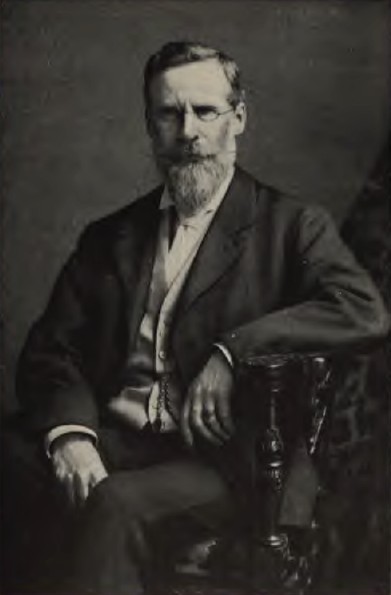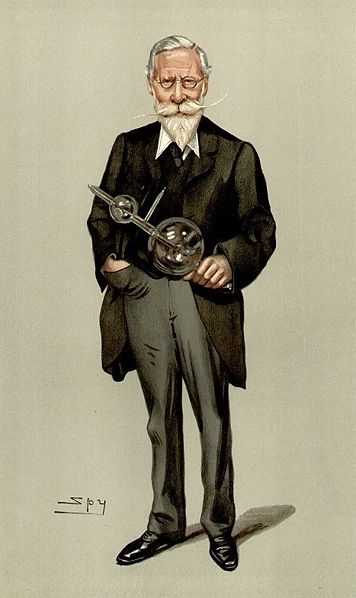<Back to Index>
- Chemist Sir William Crookes, 1832
- Composer Igor Fyodorovich Stravinsky, 1882
- King of Sweden Charles XII, 1682



Sir William Crookes, OM, FRS (17 June 1832 – 4 April 1919) was a chemist and physicist who attended the Royal College of Chemistry, in London, and worked on spectroscopy. He was pioneer of vacuum tubes, inventing the Crookes tube.
William
Crookes was born in London, the eldest son of Joseph Crookes, a tailor
of north-country origin whose second wife was Mary Scott. From
1850 to 1854 he filled the position of assistant in the college, and
soon embarked upon original work, not in organic chemistry where the
inspiration of his teacher, August Wilhelm von Hofmann, might have been expected to lead him, but on new compounds of selenium. These formed the subject of his first published papers in 1851. Leaving the Royal College, he became superintendent of the meteorological department at the Radcliffe Observatory in Oxford in 1854, and in 1855 was appointed lecturer in chemistry at the Chester Diocesan Training College. Married
now and living in London, he was devoted mainly to independent work.
After 1880, he lived at 7 Kensington Park Gardens, where all his later
work was carried out in his private laboratory. Crookes's life was one
of unbroken scientific activity. The breadth of his interests, ranging
over pure and applied science, economic and practical problems, and
psychical research, made him a well-known personality, and he received
many public and academic honours. In 1859, he founded the Chemical News,
a science magazine which he edited for many years and conducted on much
less formal lines than is usual with journals of scientific societies. Crookes was knighted in 1897, and in 1910 received the Order of Merit. In 1861, Crookes discovered a previously unknown element with a bright green emission line in its spectrum and named the element thallium, from the Greek thallos, a green shoot. Crookes also identified the first known sample of helium, in 1895. He was the inventor of the Crookes radiometer, which today is made and sold as a novelty item. He also developed the Crookes tubes, investigating canal rays. In his investigations of the conduction of electricity in
low pressure gases, he discovered that as the pressure was lowered, the
negative electrode (cathode) appeared to emit rays (the so-called cathode rays, now known to be a stream of free electrons, and used in cathode ray display devices). As these examples indicate, he was a pioneer in the construction and use of vacuum tubes for the study of physical phenomena. He was, as a consequence, one of the first scientists to investigate what are now called plasmas. He also devised one of the first instruments for the study of nuclear radioactivity, the spinthariscope.
Crookes worked over both fields of chemistry and physics. Its salient characteristic was the originality of conception of his experiments, and the skill of their execution. Crookes was always more effective in experiment than in interpretation. The method of spectral analysis, introduced by Bunsen and Kirchhoff,
was received by Crookes with great enthusiasm and to great effect. His
first important discovery was that of the element thallium, announced
in 1861, and made with the help of spectroscopy. By this work his
reputation became firmly established, and he was elected a fellow of the Royal Society in 1863. Crookes'
attention had been attracted to the vacuum balance in the course of
thallium research. He soon discovered the phenomenon upon which depends
the action of the Crookes radiometer,
in which a system of vanes, each blackened on one side and polished on
the other, is set in rotation when exposed to radiant energy. Crookes
did not, however, provide the true explanation of this apparent
"attraction and repulsion resulting from radiation". He published numerous papers on spectroscopy and conducted research on a variety of minor subjects. In addition to various technical books, he wrote a standard treatise on Select Methods in Chemical Analysis in 1871, and a small book on diamonds in 1909. Crookes investigated the properties of cathode rays, showing that they travel in straight lines, cause phosphorescence in
objects upon which they impinge, and by their impact produce great
heat. He believed that he had discovered a fourth state of matter,
which he called "radiant matter", but his theoretical views on the
nature of "radiant matter" proved to be mistaken. He believed the rays
to consist of streams of particles of ordinary molecular magnitude. It
remained for Sir J.J. Thomson to discover their subatomic nature, and to prove that cathode rays consist of streams of negative electrons, that is, of negatively electrified particles whose mass is only 1/1840 that of a hydrogen atom.
Nevertheless, Crookes's experimental work in this field was the
foundation of discoveries which eventually changed the whole of
chemistry and physics. In 1903, Crookes turned his attention to the newly discovered phenomena of radioactivity, achieving the separation from uranium of its active transformation product, uranium-X (later established to be protactinium). He observed the gradual decay of
the separated transformation product, and the simultaneous reproduction
of a fresh supply in the original uranium. At about the same time as
this important discovery, he observed that when "p-particles", ejected from radio-active substances, impinge upon zinc sulfide,
each impact is accompanied by a minute scintillation, an observation
which forms the basis of one of the most useful methods in the
technique of radioactivity. In 1870 Crookes decided that science had a duty to study preternatural phenomena associated with Spiritism. Judging from family letters, Crookes had already developed a
favorable view of Spiritism by 1869.
In this he was possibly influenced by the untimely death of his young
brother Philip in 1867 at age 21 from yellow fever contracted while on
an expedition to lay a telegraph cable from Cuba to Florida. Nevertheless, he was determined to conduct his inquiry
impartially and described the conditions he imposed on mediums as
follows: "It must be at my own house, and my own selection of friends
and spectators, under my own conditions, and I may do whatever I like
as regards apparatus". Among the mediums he
studied were Kate Fox, Florence Cook, and Daniel Dunglas Home.
Among the phenomena he witnessed were
movement of bodies at a distance, rappings, changes in the weights of
bodies, levitation, appearance of luminous objects, appearance of
phantom figures, appearance of writing without human agency, and
circumstances which "point to the agency of an outside intelligence".
To find support and assistance for his research, he joined the Society for Psychical Research. His
report on this research in 1874, concluded that these phenomena could
not be explained as conjuring, and that further research would be
useful. Crookes was not alone in his views. Fellow scientists who came
to believe in Spiritualism included Alfred Russel Wallace, Oliver Joseph Lodge, Lord Rayleigh, and William James. Nevertheless, most scientists were convinced that
Spiritism was fraudulent, and Crookes' final report so outraged the
scientific establishment "that there was talk of depriving him of his
Fellowship of the Royal Society." Crookes then became much more
cautious and didn't discuss his views publicly until 1898, when he felt
is position was secure. From that time until his death in 1919, letters
and interviews show that Crookes was a believer in Spiritism. In
1856 he married Ellen, daughter of William Humphrey, of Darlington, by
whom he fathered three sons and a daughter. He died in London on 4
April 1919, two years after his wife. He is buried in London's Brompton Cemetery.